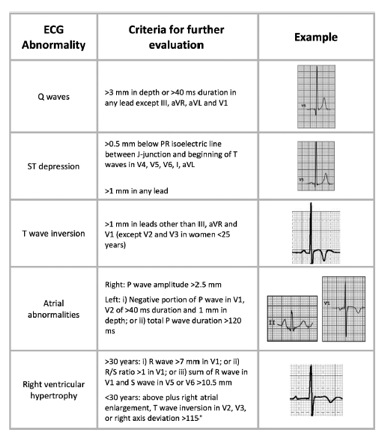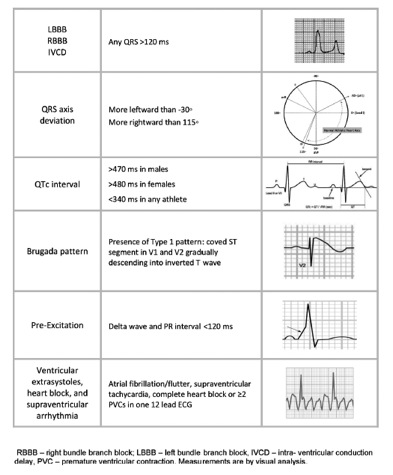 Should 12-lead ECG be part of the pre-participation examination of athletes? Those in favor of ECG screening argue that it reduces the risk of sudden cardiovascular death; those against screening point out the low cost-effectiveness, the low disease prevalence resulting in a low positive predictive value, the difficulties in distinguishing abnormal electrocardiographic changes indicative of cardiac pathology from normal, training-induced alterations and the inconsistencies in the definition of ECG abnormalities.
Should 12-lead ECG be part of the pre-participation examination of athletes? Those in favor of ECG screening argue that it reduces the risk of sudden cardiovascular death; those against screening point out the low cost-effectiveness, the low disease prevalence resulting in a low positive predictive value, the difficulties in distinguishing abnormal electrocardiographic changes indicative of cardiac pathology from normal, training-induced alterations and the inconsistencies in the definition of ECG abnormalities.
New perspective
In a recent edition of Circulation, Uberoi et al. tackled this obstacle of the varying definition of ECG abnormalities and have written a good, educational article that focuses on the interpretation of the electrocardiogram of athletes (Interpretation of the electrocardiogram of young athletes, Circulation 2011;124:746-757)
The European Society of Cardiology recently published new recommendations for the interpretation of the ECG in athletes. The strength of this current article by Uberoi et al. is that it builds on the guidelines of the European Society of Cardiology, but elaborates this even further, refines the recommendations, and includes excellent figures to illustrate the various examples.
Uberoi’s article discusses specific aspects of interpretation, presents the author’s commendations and then critiques the document of the European Society of Cardiology. The following aspects of the ECG are discussed: Increased QRS voltage, early repolarization, Q waves, conduction delay, QRS axis deviation, right ventricular hypertrophy, atrial abnormalities, T-wave inversion, ST depression, QT abnormalities (long and short), Brugada-like abnormalities and ARVD, ventricular preexitation, and ventricular extrasystoles and supraventricular arrhythmia.
The main conclusions and recommendations of the article are summarized in one clear table (Table 5 – split between two pages, 753-4).
A very useful and educational for anyone who is involved in the ECG screening of athletes! Read this great article in Circulation. And remember, sports cardiology is a major focus of BJSM – see the September 2009 issue (still highly topical), read the WarmUp for that issue, and listen to Senior Associate Editor Jon Drezner’s recent podcast of updates on sports cardiology. Previous blogs too! Hot hot hot!!

